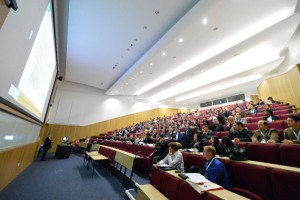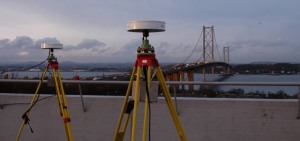News in 2013

|
2nd Joint International Symposium on
Deformation Monitoring
9-10 September 2013,
Nottingham, United Kingdom

JISDM: Conference chairs and speakers
At the University of Nottingham, UK, a joint international symposium was
organised on deformation monitoring of large engineering structures and
(local to regional) geo-hazards.
After the Hong Kong meeting in 2011 this was the second time that FIG
(Commission 6, WG 6.1 “Deformation Measurements and Analysis”) and IAG
(International Association of Geodesy, Commission 4 “Positioning and
Applications”) has organized a joint symposium on this topic, following up
the long series of individual symposia within FIG (since 1975) and IAG
(since 1996). This time the International Society for Photogrammetry and
Remote Sensing (ISPRS, Commission V “Close-Range Sensing: Analysis and
Applications”) has joint this group as 3rd international geospatial
association.
This common interest of these sister organisations is understandable, as
deformation monitoring of both man-made structures and critical natural
sites is an important aspect of our scientific and practical activities.
Structural failures such as collapses of dams, tunnels, bridges or buildings
and geo-hazards caused by events such as landslides, ground subsidence and
earthquakes are world-wide problems that often lead to significant economic
and life losses. It is therefore important for society to carry out
systematic research and development to a better understanding and management
of these problems.
Rapid developments in our professional fields, like modern sensors and
sensor networks, real-time processing algorithms, advanced analysis tools,
micro-electronics and computer sciences, wireless communications and machine
control have significantly changed instrumentation, methodology and system
set-up. The symposium emphasized the high demands to develop new monitoring
concepts and solutions to meet the needs of society in minimizing negative
environmental impacts.
This 2nd JISDM was held on the charming campus of the University of
Nottingham on September 9-10, 2013. Around 200 people from 26 countries
attended the conference, with a strong group from China due to the local
conference chair, Dr. Xiaolin Meng, who is Director of the Nottingham
Sino-UK Geospatial Engineering Centre, but indicating an increasing interest
in China in this topic, too. For this 2nd JISDM 180 paper abstracts were
submitted, 80 papers were selected for oral presentations in 20 parallel
sessions and 30 paper abstracts were presented as posters. Additionally six
student paper prizes were awarded. Ten organisations and companies presented
their latest deformation monitoring solutions at the associated exhibition.

Conference hall at 2nd JISDM in Nottingham, UK
There were four keynote speeches in the opening ceremony. Professor
Chris Rizos, President of the IAG, gave a talk on “Engineering Geodesy:
Its Links to Modern Geodetic Practice”; Professor Andreas Weiser from
ETH Zurich presented “From Spatially Discrete to Areal Deformation Analysis:
Methodical and Instrumental Challenges in Terrestrial Geomonitoring”; Mr Barry Colford, Bridgemaster of the Forth Road Bridge, discussed “The
Maintenance of Long Span Bridges”; and Dr Xiaolin Meng, as JISMD
organiser, introduced the topic “GeoSHM: GNSS and EO for Structural Health
Monitoring of Bridges”.
After the conference a technical tour was arranged for 38 people to the
Forth Road Bridge, Scotland, on September 11-12. The current Forth Road
Bridge was the longest suspension bridge outside the USA when it was opened
in 1964. The Forth Bridge, a railway bridge adjacent to the road bridge,
when it was opened in 1890 was the first major structure in Britain to be
constructed of steel. Technical staff guided these JISDM delegates to see
the maintenance facilities, describe their current and future difficulties
in bridge management, and to visit the Forth Bridge and the new Forth Road
Bridge (named the “Queensferry Crossing”) site.
Undergoing a complete peer-review process the conference papers will be
published as special issues of five journals: Journal of Navigation, Survey
Review, Journal of Applied Geodesy, Applied Geomatics and ICE Forensic
Engineering.
The next JISDM is intended to be organized in about two year. A bidding
to take over the organisation of this meeting is open right now.
Wolfgang Niemeier, Chris Rizos and Xiaolin Meng

GPS Antennas in front of Forth Road Bridge, Scotland
19 November 2013
|

